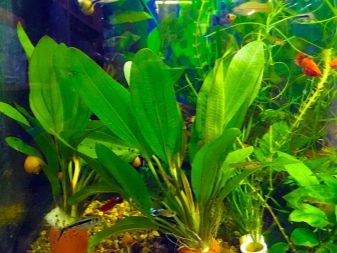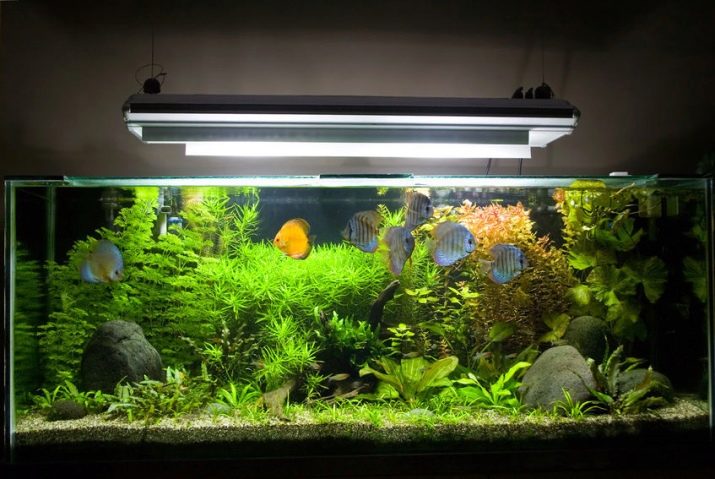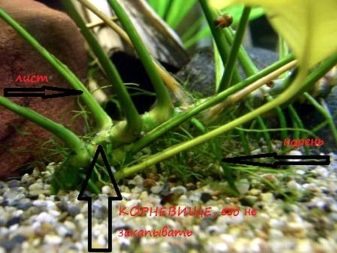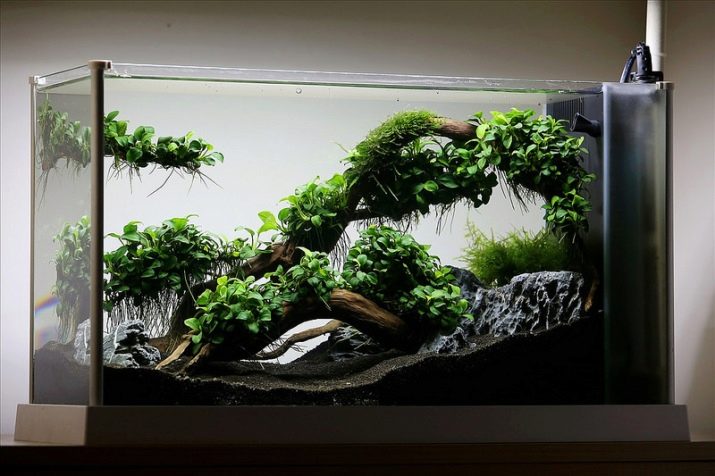Anubias is a flowering plant from a small genus of the same name belonging to the Aroid family. The genus Anubias is distributed in a relatively small territory - in West Africa. All species are inhabitants of tropical swamps and are, above all, near-water plants. However, due to the peculiarities of the climate of their habitat, they periodically undergo complete flooding, which sometimes can last almost six months. At this time, the plant slows down its growth, and after the onset of the dry period continues to grow. This ability allowed the use of anubias as landscaping for aquariums. However, they still feel more comfortable in a humid terrarium or paludarium (artificial swamp).

Description
Like an aquarium plant, Anubias remains quite exotic. At the same time, despite a number of difficulties growing, it is great for a tropical aquarium. Large forms with dark green leaves can be a great backdrop for more delicate plants. The dwarf form is a good decoration on the bottom of any aquarium. When immersed, the plant grows slowly, without violating the overall design of the interior of the aquarium and without requiring serious surgical interventions.
Anubias flowering in an aquarium is a rare occurrence. Under natural conditions, it occurs during the period of terrestrial growth, when the active growth of the plant begins. Anubias grows much better and blooms regularly in a wet greenhouse or paludarium.Nondescript inflorescence - the ear is protected by a thin cover sheet. A characteristic feature of all members of the genus are thick rhizomes, sometimes reaching 1.5 cm in thickness. The rhizome easily branches, growing in the surface layer of the soil, numerous roots that hold the plant depart from it.
The leaves are dense, with constant flooding, they grow very slowly, so they are often covered with a bloom of algae. Leaf shape - from ovoid to lanceolate. A longitudinal protruding vein is clearly visible on the lower surface of the sheet. Having dense covers, leaves of anubias successfully resist mollusks and herbivorous fish. Even catfish cannot dig out an overgrown rhizome.


However, the plant may suffer from turbidity settling on the leaves. To avoid this, a reliable filtration system must be created in the aquarium.
Varieties
The genus Anubias has a total of 12 species described. They differ in similar growing conditions, due to the almost identical area of natural growth. In aquaristics, the most widespread are several varieties of this plant.
- Anubias Afcellii. One of the varieties of this species is the well-known lanceolate anubias. The plant is grown both in aquariums and in paludariums, where it grows much more actively. This is a fairly large plant and in the aquarium can reach 50 cm in height. The best place to plant it is the space in the corners at the back wall of a large aquarium with a dense carpet of floating plants that impede the direct distribution of light. Usually no more than 7 leaves grow from the rhizome.

- Anubias nana. Anubias nana or dwarf is one of the subspecies of Anubias barteri. It differs from the lanceolate described above in its miniature size. This variety is able to cover the bottom of the aquarium with a dark green carpet. Small oval leaves are very densely located on short shoots - rhizomes. After a few years, Nana reaches a maximum height of 10 cm, the number of leaves can reach up to 20. The best part for the dwarf variety is the front of the aquarium.

- Anubias gigantean. Giant anubias is a very rare plant in aquariums, which has become more common in greenhouses and paludiriums. At home in West Africa, the leaves of a plant of this species can reach 1 m in height. It grows well in large semi-submerged aquariums. A distinctive feature is the variety of sheet plate shapes, from typical lanceolate to swept. This is the record holder for the number of simultaneously growing leaves among all anubias, there may be more than 35.

- Variegated is also called another large species. Anubias congensis (Congolese). This plant, like the previous one, is preferable to contain semi-immersed or in the paludarium.

What kind of fish can I keep with?
Anubias are grown in a tropical aquarium, at the same time it can contain any small tropical fish. However, there are still a number of limitations. Actively digging fish, such as most catfish, raise a large amount of turbidity from the bottom - small particles of soil and silt. This suspension, settling, can fall on the leaf plates of anubias. Due to the slow growth of leaf renewal practically does not occur, contaminated leaves are gradually destroyed, which can lead to the death of the whole plant. Regular filtration and weekly water changes will help to reduce the described effect.

It is completely undesirable to keep large catfish (pterygoplichitis or plecostomus) in an aquarium with anubiuses. During the night, in search of food, they are able to completely dig through the soil and dig even plants with a powerful root system. It should be noted that only floating plants can get along with such neighbors.
At the same time, a small relative of the large catfish mentioned above - Antcistrus, on the contrary, will be very useful for Anubius neighbors. Due to the structural features of the oral apparatus, it is able to clean algal fouling from their hard leaves. Some live-bearing species (guppies, swordsmen, pecilia, molliesia) can become ideal helpers in the fight against fouling. An alternative to livestock can be a flock of gourami. One or two Labe fish will also be quite enough to deal with this unpleasant phenomenon. The well-deserved professionals of this difficult task, otocinclus and girinoheylus, will perfectly help in the fight against algae.


Growing conditions
All species of Anubias come from tropical West Africa. The climate of this territory is either equatorial - hot and humid, or subequatorial with pronounced two seasons - humid and arid. They grow along river banks or in swamps with very moist, loose and nutritious soil, preferring areas shaded by multilevel forest canopies. The air temperature in these latitudes very rarely drops below + 24 ° C. In the rainy season, water bodies leave their banks, flooding the habitat of Anubias, turning them into real inhabitants of water bodies. Some varieties of these plants feel equally good both in water and on land, but most still grow better when not submerged.
The content of any plants, including anubias, in an aquarium or a greenhouse is, first of all, aimed at creating conditions close to those created by nature in their homeland. Care for these plants consists in maintaining the parameters of the surrounding artificial environment within acceptable limits.


Despite the relative unpretentiousness, these tropical guests still require some attention.
Lighting
As already mentioned, Anubias are the inhabitants of boggy tropical forests and coastal thickets. Sunlight reaches them many times scattered, for this very reason an aquarium or a paludarium with these plants needs to be illuminated with dim light. For instance, in the aquarium at the same time you can put floating plants that love bright direct light. This will slightly reduce the luminous flux generated by the lamps. Naturally diffused lighting is very useful, but in the conditions of an artificial reservoir it is rather difficult to provide.
A good lighting problem can be solved with the help of highly efficient LED strips. This lighting option allows you to vary the intensity and the main quality of the light flux. The combination of cold and warm white allows you to simulate diffuse natural light. The inclusion in the lighting system of tapes with a different ratio of red and blue LEDs will expand the range of lighting usually lacking in the conditions of artificial cultivation necessary for plants shades.
The daylight hours for tropical plants should be 11-12 hours. It is this regime of "day and night" for Anubias that is considered optimal. Excessive lighting can contribute to the development of microscopic algae and the rapid fouling of anubias leaves.

Lack of light is also undesirable, it will cause inhibition of an already slowly growing plant.
Priming
Creating an acceptable artificial soil for Anubias is not difficult. It is important to remember that these plants have a powerful developed root system and even a dwarf anubias nana needs a fairly thick layer of soil, at least 10 cm. The particle size of the soil is preferably large, although in fact this factor is not particularly significant. The best substrate is fine pebbles or coarse sand. Due to the slow growth, the plant has enough nutrients accumulating along with the sludge and additional feeding is practically not required.


Water
The optimum water temperature for this tropical plant is about + 24 ° C. Raising the temperature to + 28– + 30 ° С is uncritical, but lowering below + 22 ° С is undesirable and can lead to stunting and slow death of the plant. Water in an aquarium with anubias must be regularly (weekly) replaced by approximately 25% of the volume and must be passed through a filter. These measures are necessary not only to ensure the flow of nutrients, but also as the main means of combating fouling.


The stiffness and reaction of the water have almost no effect on the development of the plant.
How to plant?
Planting a young plant in a new aquarium is not difficult. Planting plants of large varieties with overgrown fleshy roots is necessary by digging them in the ground along with the rhizome. In a dwarf form, it is enough to stick only the roots, leaving the rhizome on the surface. As a top dressing, it is advisable to put sludge from the old aquarium in the soil under the roots. It is important to place the plant correctly at the bottom of the prepared reservoir, for this it is necessary to take into account the intensity of lighting in various parts of the aquarium.


Breeding
So far, it has not been possible to propagate anubias with the help of seeds, as it happens under natural conditions, in aquariums or paludariums. In aquariums, the plant does not give germinating seeds ever, and it blooms extremely rarely. All modern aquarium plants of this small genus are obtained by dividing the rhizome. The final section with 3-4 leaves and several roots is separated from the overgrown rhizome, and it is planted in a new place. Soon, one or several buds appear on the rhizome of the mother plant near the cut, from which new actively growing rhizomes develop, which can be used to breed anubias.


Aquarium design options
As an aquarium decoration, anubias have undeniable advantages over most aquarium plants. They grow slowly, so they do not require frequent intervention by an aquarist trying to maintain an acceptable look for his aquarium. The possibility of combining with floating and other rooted plants makes them very convenient as a basis for the interior of a tropical aquarium. Large plants are planted at the rear wall of the aquarium or in the corners, dim lighting adds mystery to such a reservoir, The dark screen behind the back wall, creating the effect of depth, will perfectly complement the interior. Flocks of playful neon, slow discus and large scalars will look great in such an interior.

In the design of aquariums, no one variety of anubias can argue with dwarf (nana) in popularity. These plants are most advantageously placed near the front glass of the aquarium. So they do not block the overview of the rest of the space, the rhizomes protruding above the ground - a great habitat for the small inhabitants of an artificial reservoir - fish, crustaceans and mollusks. Nana thickets are always full of life, create a kind of carpet, while at the same time zoning the volume of the aquarium. Above the carpet of dwarf anubias leaves there is enough free space for actively swimming fish. Nana looks great on snags or stones.

To do this, you can use small pots with soil disguised as decorative elements.
See how to plant anubias in an aquarium in the next video.










